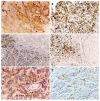Prognostic significance of HIF-2alpha/EPAS1 expression in hepatocellular carcinoma
- PMID: 17589895
- PMCID: PMC4436602
- DOI: 10.3748/wjg.v13.i23.3176
Prognostic significance of HIF-2alpha/EPAS1 expression in hepatocellular carcinoma
Abstract
Aim: To evaluate the prognostic significance of HIF-2alpha/EPAS1 expression in hepatocellular carcinoma (HCC).
Methods: Surgical specimens from 315 patients with HCC as well as 196 adjacent noncancerous lesions and 22 cases of normal liver tissue were investigated by immunohistochemistry (IHC) for HIF-2alpha/EPAS1 using a standard detection system. Correlations with clinicopathological factors, VEGF, microvessel density (MVD), and prognosis were analyzed.
Results: Immunoreactivity of HIF-2alpha/EPAS1 was positive in 69.5% of HCC, 55.6% of adjacent noncancerous tissue, and 0% of normal liver tissue. And it was significantly correlated with tumor grade, venous invasion, intrahepatic metastasis, necrosis, and capsule infiltration. Correlation analysis of HIF-2alpha/EPAS1 with angiogenic factor VEGF (P<0.001), and MVD (P=0.016) was also noted. HIF-2alpha/EPAS1 protein was less frequently expressed in low MVD cases, whereas a high rate of expression was noted in cases with both medium and high MVD (P=0.042). By Kaplan-Meier analysis, strong HIF-2alpha/EPAS1 staining (>50% of tumor cells) in HCC correlated with a shortened survival in patients (Cox's regression, P<0.001, r=3.699).
Conclusion: We conclude that HIF-2alpha/EPAS1 expression may play an important role in tumor progression and prognosis of HCC. Assessment of HIF-2alpha/EPAS1 expression in HCC may be used as a diagnostic tool and possibly a target in the treatment of HCC.
Figures


References
-
- Nagao Y, Tanaka K, Kobayashi K, Kumashiro R, Sata M. A cohort study of chronic liver disease in an HCV hyperendemic area of Japan: a prospective analysis for 12 years. Int J Mol Med. 2004;13:257–265. - PubMed
-
- Beasley RP, Hwang LY, Lin CC, Chien CS. Hepatocellular carcinoma and hepatitis B virus. A prospective study of 22 707 men in Taiwan. Lancet. 1981;2:1129–1133. - PubMed
-
- Helmlinger G, Yuan F, Dellian M, Jain RK. Interstitial pH and pO2 gradients in solid tumors in vivo: high-resolution measurements reveal a lack of correlation. Nat Med. 1997;3:177–182. - PubMed
-
- Brizel DM, Scully SP, Harrelson JM, Layfield LJ, Bean JM, Prosnitz LR, Dewhirst MW. Tumor oxygenation predicts for the likelihood of distant metastases in human soft tissue sarcoma. Cancer Res. 1996;56:941–943. - PubMed
Publication types
MeSH terms
Substances
LinkOut - more resources
Full Text Sources
Medical

